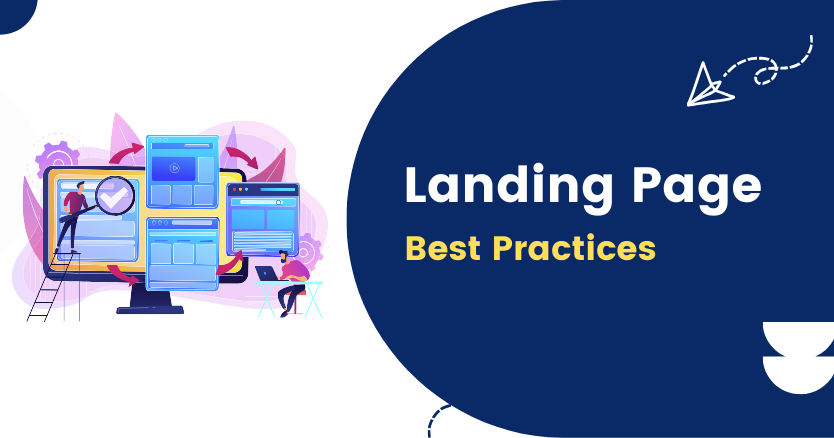
10 Landing Page Design Secrets to Skyrocket Your Conversions
In digital marketing, a landing page is often the first point of contact between your business and a potential customer. It plays a crucial role in driving conversions—capturing leads, signing up users, or making sales. A Perfect Landing Page Design is the Best Solution for that.
In this article, we’ll dive into the best practices for designing a landing page that attracts visitors and compels them to take action.
1. Crafting Compelling Headlines
Your headline is the first thing visitors will see, and it should grab attention instantly. A great headline clearly states the value proposition of your product or service. It should be relevant, concise, and emotionally engaging.
Tip: Include numbers or powerful words to make the headline stand out. For instance, “Increase Your Conversions by 30% with These Simple Tactics” clearly promises value to the reader.
2. Focus on a Strong, Actionable Call-to-Action (CTA)
The CTA is the key to driving conversions. It should be clear, concise, and immediately visible. The best CTAs don’t just tell the user what to do—they inspire action by highlighting the benefits.
Example: Instead of using a generic CTA like “Submit,” opt for something more persuasive, such as “Get My Free Guide Now” or “Start My Free Trial.” Placing multiple CTAs across your landing page, particularly above the fold, can increase engagement.
3. Simplified and Minimalistic Design
A cluttered landing page with too many distractions can overwhelm users. Focus on simplicity. Eliminate unnecessary elements, like sidebars or multiple links, which may divert the visitor’s attention from the main goal.
Best Practice: Utilize a clean, minimalistic design that emphasizes key elements like the headline, CTA, and form. By reducing the number of choices, you help users focus on the primary action you want them to take
4. Optimizing Form Placement and Asking for Minimal Information
Placing your form above the fold (where visitors don’t need to scroll) can increase visibility. But even more crucial is minimizing the number of form fields. Studies show that asking for fewer details improves conversion rates dramatically.
Tip: Start by requesting only essential information (like name and email), and use progressive profiling later to gather more data over time. Reducing form fields from four to three can increase conversion rates by up to 50%
5. Mobile-Friendly and Responsive Design
With a significant portion of web traffic coming from mobile devices, optimizing your landing page for mobile users is no longer optional—it’s essential. A responsive design ensures that your page looks great and functions smoothly on all devices, from desktops to smartphones.
Best Practice: Use large, easily clickable buttons, fast-loading elements, and mobile-friendly forms to provide a seamless experience across devices.
6. A/B Testing and Personalization
Continuous optimization through A/B testing allows you to compare different versions of your landing page to see what works best. From headlines to CTA button colors, small tweaks can make a huge difference.
Example: You can personalize your landing page by dynamically changing content based on the visitor’s location, referral source, or behavior. This creates a more relevant experience, increasing the likelihood of conversion.
7. The Science of Visual Elements
High-quality visuals can significantly impact the performance of your landing page. Use images and videos that support your message and align with your brand.
Tip: Visual hierarchy is important—highlight the most critical elements, like the CTA or headline, by making them larger or using contrasting colors. Ensure your visuals don’t overshadow the key message.
8. Copywriting Tips for Landing Pages
Compelling, benefit-oriented copy is essential for keeping visitors engaged. Keep your language simple, direct, and focused on how your product or service solves the visitor’s problem.
Frameworks: Use storytelling techniques like the Problem-Agitate-Solve (PAS) framework to guide the reader toward conversion. Start by presenting a problem, agitate it by highlighting its impact, and offer your product as the solution
9. Creating a Sense of Urgency
Urgency is a powerful motivator. By adding elements like countdown timers or limited-time offers, you can encourage visitors to act quickly.
Tip: Use urgency sparingly and strategically to avoid overwhelming users. You could offer limited-time discounts or highlight scarcity, such as “Only 5 seats left.”
10. Social Proof and Trust Signals
Building trust is essential in converting visitors into customers. Displaying social proof like testimonials, customer reviews, or case studies helps reinforce your credibility.
Tips: Including trust badges (such as security certifications or logos from major clients) on your landing page can increase your visitors’ confidence in your offer.
Conclusion
An effective landing page is more than just a pretty design—it’s a carefully crafted tool that encourages action. By implementing these best practices, from compelling CTAs to A/B testing and trust signals, you can create landing pages that not only attract traffic but also convert visitors into customers. Take the time to experiment with these strategies and fine-tune them for your audience to maximize results.





